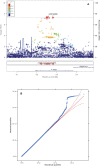Genome-wide association study of pain sensitivity assessed by questionnaire and the cold pressor test
- PMID: 34924555
- PMCID: PMC9393798
- DOI: 10.1097/j.pain.0000000000002568
Genome-wide association study of pain sensitivity assessed by questionnaire and the cold pressor test
Abstract
We deployed an online pain sensitivity questionnaire (PSQ) and an at-home version of the cold pressor test (CPT) in a large genotyped cohort. We performed genome-wide association studies on the PSQ score (25,321 participants) and CPT duration (6853). We identified one new genome-wide significant locus associated with the PSQ score, which was located in the TSSC1 (also known as EIPR1 ) gene (rs58194899, OR = 0.950 [0.933-0.967], P -value = 1.9 × 10 -8 ). Although high pain sensitivity measured by both PSQ and CPT was associated with individual history of chronic and acute pains, genetic correlation analyses surprisingly suggested an opposite direction: PSQ score was inversely genetically correlated with neck and shoulder pain ( rg = -0.71), rheumatoid arthritis (-0.68), and osteoarthritis (-0.38), and with known risk factors, such as the length of working week (-0.65), smoking (-0.36), or extreme BMI (-0.23). Gene-based analysis followed by pathway analysis showed that genome-wide association studies results were enriched for genes expressed in the brain and involved in neuronal development and glutamatergic synapse signaling pathways. Finally, we confirmed that females with red hair were more sensitive to pain and found that genetic variation in the MC1R gene was associated with an increase in self-perceived pain sensitivity as assessed by the PSQ.
Copyright © 2022 The Author(s). Published by Wolters Kluwer Health, Inc. on behalf of the International Association for the Study of Pain.
Conflict of interest statement
The authors have no conflicts of interest to declare.
Sponsorships or competing interests that may be relevant to content are disclosed at the end of this article.
Figures



References
-
- Andresen T, Lunden D, Drewes AM, Arendt-Nielsen L. Pain sensitivity and experimentally induced sensitisation in red haired females. Scand J Pain 2011;2:3–6. - PubMed
-
- Battle A, Mostafavi S, Zhu X, Potash JB, Weissman MM, McCormick C, Haudenschild CD, Beckman KB, Shi J, Mei R, Urban AE, Montgomery SB, Levinson DF, Koller D. Characterizing the genetic basis of transcriptome diversity through RNA-sequencing of 922 individuals. Genome Res 2014;24:14–24. - PMC - PubMed
-
- BIOS Consortium, Social Science Genetic Association Consortium, Baselmans BML, Jansen R, Ip HF, van Dongen J, Abdellaoui A, van de Weijer MP, Bao Y, Smart M, Kumari M, Willemsen G, Hottenga JJ, Boomsma DI, de Geus EJC, Boomsma DI, de Geus EJC, Nivard MG, Bartels M. Multivariate genome-wide analyses of the well-being spectrum. Nat Genet 2019;51:445–51. - PubMed
Publication types
MeSH terms
LinkOut - more resources
Full Text Sources

